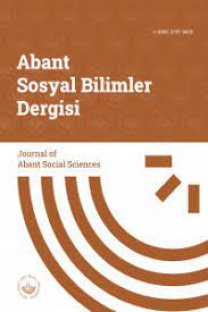DİL KAYGISI VE YABANCI DİL SINIFLARINDA AZALTILMASININ OLASI YOLLARI
Dil Kaygısı, Yabancı Dil Öğrenimi, İngilizce Öğretimi, Konuşma kaygısı, dil konuşma kaygısının azaltılması
THE LANGUAGE ANXIETY AND POSSIBLE WAYS OF REDUCTION IT IN EFL CLASSES
___
- Abu-Rabia, S. (2004). Teachers' Role, Learners' Gender Differences, and FL Anxiety Among Seventh-Grade Students Studying English as a FL. Educational Psychology, Vol. 24(5), 711-721 Aida, Y. (1994). Examination of Horwitz, Horwitz, and Cope's construct of foreign language anxiety: The case of students of Japanese. The Modern Language Journal, 78(2), 155-168. Akalin, S. (2015). The discourse in Mrs. Dalloway by Virginia Woolf and foreign language teaching: the decline of language learner anxiety by the usage of hedges, particular modals and adverbs as in the usage of these structures in Mrs. Dalloway for a specific purpose. Procedia - Social and Behavioral Sciences, 174, 3049 – 3054. Atas, M. (2015). The reduction of speaking anxiety in EFL learners through drama techniques Procedia - Social and Behavioral Sciences, 176, 961-969. Elkhafaifi, H. (2005). Listening comprehension and anxiety in the Arabic language classroom. The Modern Language Journal, 89(2), 206-220. Gardner, R. C. & Macintyre, P. D. (1993). A student's contribution to Second Language Learning: Part II, Affective Factors. Language Teaching, 26, 1-11. Horwitz, E. K., Horwitz, M. B., & Cope, J. (1986). Foreign Language Classroom Anxiety. The Modern Language Journal. Vol. 70(2), 125–132. Horwitz, E.K. (1990). Attending to the affective domain in the foreign language classroom. S.S. Magnan (Ed.), Shifting the instructional focus to the learner, Northeast Conference of Foreign Language Teachers, Middlebury, VT, 15–33. Horwitz, E.K. (2001). Language Anxiety and Achievement. Annual Review of Applied Linguistics. Vol. 21, 112-126. Karabıyık, C. (2012). Foreign Language Anxiety: A study at Ufuk University Preparatory School. (Master of Arts), Gazi University, Ankara. (311023) Karaca, M. (2012). Foreign language anxiety in receptive language skills in ELT classroom at Necmettin Erbakan University. (Master of Arts), Necmettin Erbakan University, Konya. (311813) Machida, S. (2001). Anxiety in Japanese-language class oral examinations. In Sekai no Nihongo Kyoiku (11th) (115–138). Tokyo: Japan Foundation. MaCIntyre, P. D. (1999). Language Anxiety: A Review of Literature for Language Teachers. In Affect In Foreign Language and Second Language Learning (24 – 43). New York: Mc Graw Hill Companies. Mak, B. (2011). An exploration of speaking-in-class anxiety with Chinese ESL learners. System, 39, 202-214. Matsuda, S., & Gobel, P. (2004). Anxiety and predictors of performance in the foreign language classroom System, 32, 21-36. Mercer, S. (2011). Towards an Understanding of Language Learner Self- concept. In: Educational Linguistics, vol. 12. Springer Science + Business Media B. V. Özütürk, G., & Hürsen, Ç. (2013). Determination of English Language Learning Anxiety in EFL Classrooms. Procedia - Social and Behavioral Sciences, 84, 1899 – 1907. Saeidi, M. & Jabbarpour, N., (2011). EFL teachers’ socio-affective strategy use in relation to students’ academic achievement. International Journal of Academic Research, 3(3), 746-750 Yalçın, Ö., & İnceçay, V. (2014). Foreign language speaking anxiety: The case of spontaneous speaking activities. Procedia - Social and Behavioral Sciences, 116 (2620 – 2624). Yim, S. Y. (2014). An anxiety model for EFL young learners: A path analysis. System, 42, 344-354. Zerey, Ö. G. (2008). Impact of theater production on elt students' foreign language speaking anxiety. (Master of Arts), Mustafa Kemal University, Hatay. (215626)
- Yayın Aralığı: 3
- Başlangıç: 2000
- Yayıncı: Abant İzzet Baysal Üniversitesi Sosyal Bilimler Enstitüsü
ÇOCUK YETİŞTİRME TUTUM ÖLÇEĞİNİN GELİŞTİRİLMESİ: GEÇERLİK VE GÜVENİRLİK ÇALIŞMASI
Fatma ELİF KILINÇ, Neriman ARAL
DİL KAYGISI VE YABANCI DİL SINIFLARINDA AZALTILMASININ OLASI YOLLARI
İbrahim And UYANIK, Burak CÖBEK, Gül Deniz BAŞTÜRK, Yunus UĞUR
KELİMELERİN ALTINDAKİ KELİMELER: NAOMI SHIHAB NYE ŞİİRLERİNİN HARİTASI
PEDOGOJİK FORMASYON EĞİTİMİ ALAN ÖĞRENCİLERİN UZAKTAN EĞİTİME YÖNELİK TUTUMLARI
GELENEKSEL OLMAYAN BİR PARA POLİTİKASI ARACI OLARAK SÖZLE YÖNLENDİRME
BATI FELSEFESİ BAĞLAMINDA SCHOPENHAUER’A GÖRE AKIL VE HAKİKAT
TÜRKİYE’DE SÜRGÜN BİR ALMAN NEOLİBERAL: WİLHELM RÖPKE
Mehmet Emin YARDIMCI, Sema YILMAZ GENÇ
FUTBOL TARAFTARLARINI ŞİDDETE YÖNELTEN FAKTÖRLERİN İNCELENMESİ
